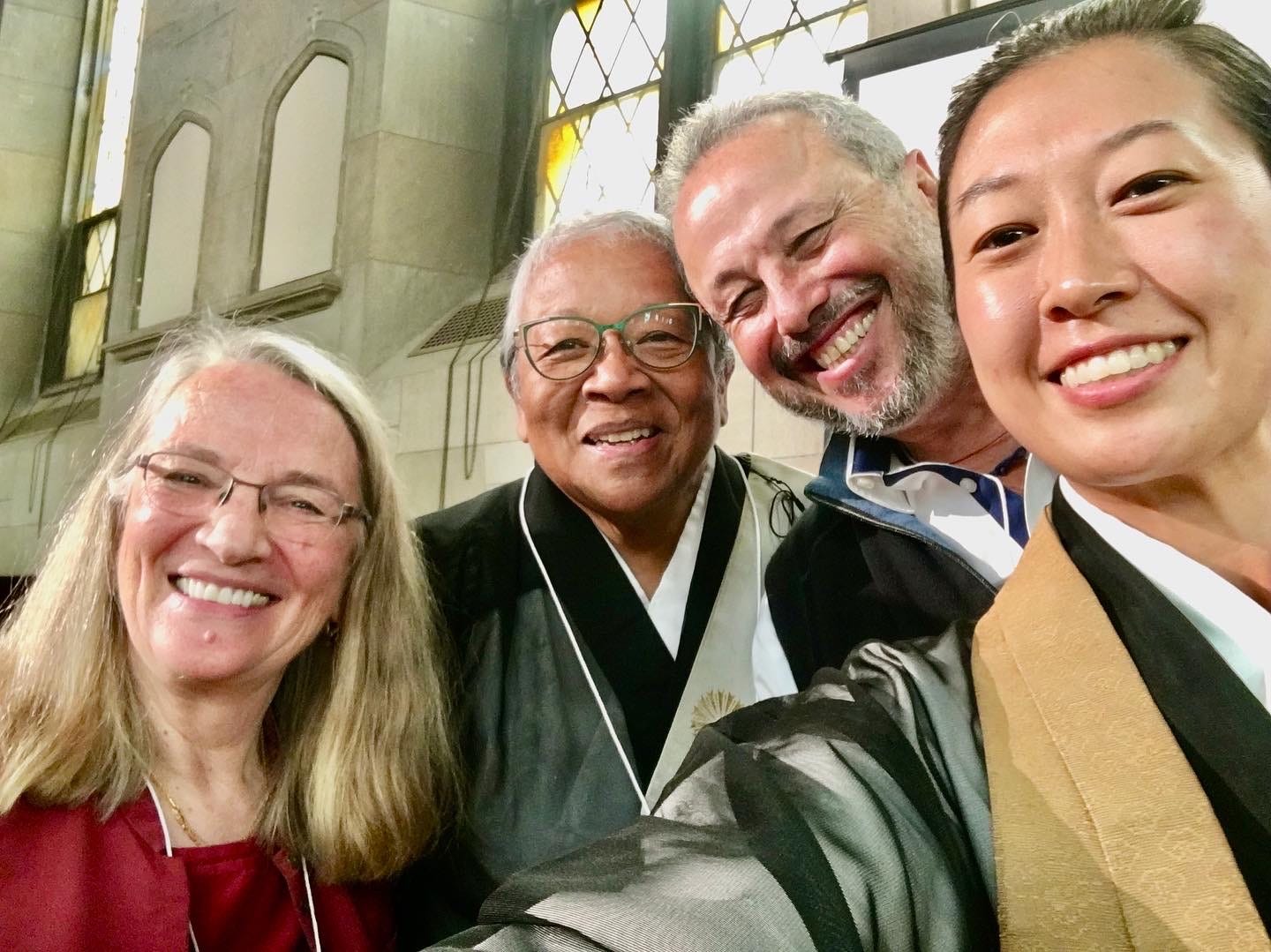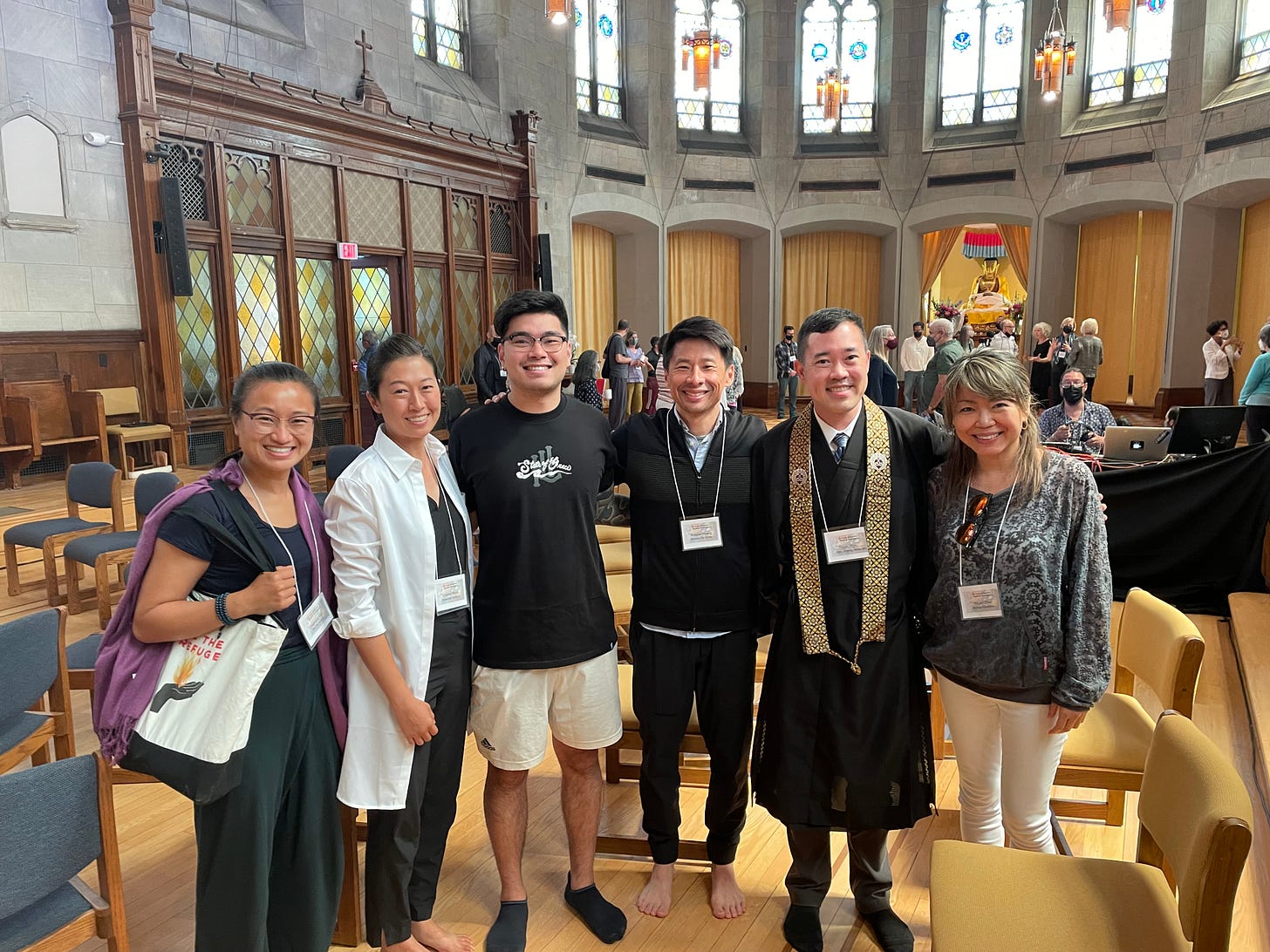The Future of American Buddhism
Yelling, learning, and connecting with the future of American Buddhism at Naropa University's conference in Garrison, NY, June 2-5

"You should do a katsu!" exclaimed Sayama Roshi, my Zen teacher, before I left for the Future of American Buddhism conference at the Garrison Institute in New York.
"A katsu?" I had asked Sayama Roshi skeptically, unsure how the customary Zen yell would go over with the conference crowd. But, in the end, I did do it in Garrison, finding the right moment as the AV staff turned on the projector and raised a screen for me just before my presentation.
Standing in front of about 100 masked people, I held the palms of my hands together in gassho and then walked slowly over to the giant, Tibetan-style Buddha statue sitting at the far end of the former Catholic abbey. I planted my feet. A fist in my right hand, I slowly raised my arm in front of me, as if painting a large circle in the air. I inhaled loudly through my mouth, grimacing and making a kind of Darth Vader sound. At the top of my inhale, I stopped my breath and set the air inside my belly. Then, I let it all out in one go.
"KATSU!!" I yelled at the top of my lungs. The acoustics of the former abbey were wonderful. I heard the resonance in my own voice carry across the hall, everything else silent. After bowing to the Buddha, I held gassho again and returned to my seat. To my great satisfaction, the timing was just right. The projector screen was clicked into place just as I arrived.
To the assembled crowd (plus 100 more tuning in online), I then spoke about the only thing I feel really expert in: my own experience training at Chozen-ji. I told them about how I began training in the martial arts and fine arts here and especially how, when I first started in Kendo, I would duck whenever a sword cut was coming my way.
For the record, ducking and putting your head down is about the worst thing you can do in Kendo. It exposes the softer part of your helmet whereas, if you stand chin up and face the blow, the sword will landland more or less painlessly on the metal grate that protects your face. But still, over and over again, I ducked in the face of every oncoming blow. I ducked so much and so regularly made myself small that it didn't take long for a very sore lump to appear on the top of my head.
Over time, I learned to stand tall and face the sword rather than try to defensively outmaneuver or go around my obstacles. Then, as more new students came after me, I saw how not just ducking but the full range of fight-flight-freeze responses could be brought out by Kendo. And then, over time and with more training, I saw each person also transcend these initial, instinctual behaviors, learning to stand tall and charge into the fold just like I had.
There are outsiders who sometimes see our schedule of classes in Japanese arts like Kendo and dismiss Chozen-ji as "just doing cultural activities." I pointed to these critics in my presentation at the Future of American Buddhism Conference and also at transformations I've seen people go through. I pointed to the latter as evidence of how the arts at Chozen-ji are not just athletic or aesthetic endeavors, but Zen training. Apropos to the topic of our panel, Tradition and Innovation in American Buddhism, the integration of the martial arts into Zen at Chozen-ji was truly, I said, a Buddhist innovation.

And, of course, I explained the katsu. The katsu, I said, is a shout in Chinese and Japanese Zen that is meant to shatter the limited, rational mind and expose the enlightened mind.
"So, did you expose their enlightened minds?" Sayama Roshi asked after my return home to Chozen-ji.
"I don't think so," I responded, laughing at myself and how far I still have to go in my own training.
Perhaps the most remarkable thing about the Future of American Buddhism Conference was this, that it was driven by people like me rather than by celebrity Buddhist teachers giving keynotes. All of us speakers were temple and community leaders who are out "on the front lines" of American Buddhism. Many would still consider themselves green grasshoppers, which is how I regard myself, not yet able to expose the enlightened mind. But we still had much to contribute and talk about, and our on-the-ground experience kept our conversations practical, rather than devolving into the usual self help vibe of other Buddhist and spiritual conferences.

Among the many wonderful presentations, a few stood out to me. Researcher Ann Gleig shared her remarkable work with co-researcher Amy Langenberg documenting abuses of power, including sexual abuse, within American Buddhism and what Buddhist communities are doing to prevent and respond to harm. Stephanie Kazu and Kristin Barker shared different ways that Buddhist temples and centers could combat climate change and engage in environmental justice. Chenxing Han and Myokei Caine-Barrett (who was also on my Tradition and Innovation panel along with Alejandro Chaoul) spoke about the many acts of Socially Engaged Buddhism that are woven into the everyday activities of some Buddhist temples, ranging from prison ministry to free dental care. And we all pondered what direction American Buddhism might take in a post-COVID world, with many communities having taken their teaching and services online. I was particularly pleased to hear from Devon Matsumoto, founder of the Young Buddhist Editorial, an online magazine for young Shin Buddhists. His purpose was simple and clear: to give himself and his peers a chance to see themselves reflected in media and pop culture representations of who's Buddhist in America. And what better place for a bunch of Gen Zs to do it than online.
One of the comments I heard in response to my katsu was an expression of gratitude that I "woke people up." And it did seem that something stirred in the gathering after I broke the conference's usual academic quietude with a loud yell. Subsequent speakers broke away themselves from the usual just talking by playing recordings of loud Nichiren chanting and prostrating to the Buddha. It made me hopeful that I not just gave a moving depiction of our training here at Chozen-ji but, instead, brought forth its spirit—decisive, clear, and leaning forward into the future. I look forward to other opportunities to continue the discussion about what innovation can look like in Buddhism, and to share Chozen-ji's both traditional and innovative approach.


